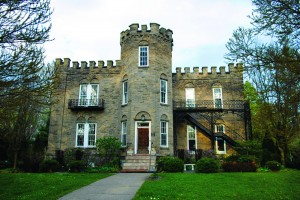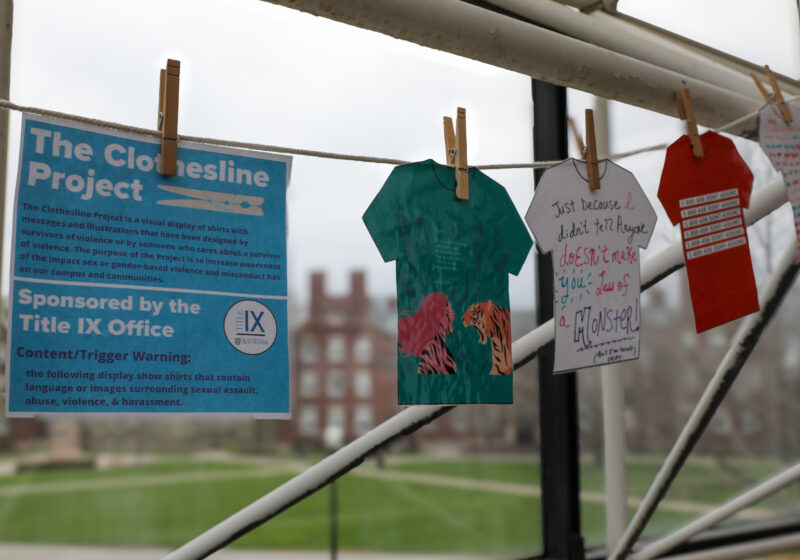
Julia Sklar, Presentation Editor
F. Scott Fitzgerald included mysterious references to it in his short stories. Vampire Weekend’s first album cover depicts a chandelier from a house at Columbia University, where it was founded. A castle near Mount Hope cemetery houses weekly meetings for one of its chapters, which can be found here at UR.
The aura of secrecy and mystique surrounding St. Anthony Hall — UR’s second oldest fraternity that was originally founded in the 1850s, shuttered by the late 1800s and reopened by a group of undergraduates in the spring of 2010 — is integral to the little-known society’s purpose: to inculcate literary and artistic creativity and to foster the self-discovery process of its members.
St. Anthony Hall is a literary society that describes itself in its official mission statement as “a true fraternity dedicated to the love of education and the well being of its members” that remains “to this day a group of college students interested in the bonds of fraternity and sharing a common passion for the love of learning and the appreciation of a well-rounded education.” The first chapter was founded at Columbia University on January 17, 1847 — the feast day of St. Anthony — though the fraternity has no religious affiliation.
Currently, 11 active chapters of St. Anthony Hall exist, most at universities on the east coast, some of which have as many as 60 to 80 members and all of which have strong ties to the other chapters.
The UR chapter is co-ed and was re-founded by a group of six students who came across references to the fraternity and decided to pursue reestablishing a chapter, according to former president and senior Julieta Gruszko, who is still a member of the fraternity.
Gruszko was a member of the first pledge class, which consisted of five people. She said she envisioned St. Anthony Hall as a type of French literary salon when first approached about the group by her friend Catherine Steele ’11 — one of the six re-founders.
St. Anthony Hall currently has 15 members — 11 of them active — and aims to hit 20 to 25, though not more, since the idea is “that everyone knows each other well,” Gruszko said.
The members also do not live together. The re-founding members lived together in the Community Learning Center (CLC) on the Fraternity Quadrangle, but some cliques arose that ran counter to the founding tenet of St. Anthony Hall’s mission. Living together in a house off campus is, however, a goal that the fraternity envisions coming to fruition within the next five to 10 years.
St. Anthony Hall is not currently recognized by UR in any capacity — a hindrance to the fraternity. The re-founding group originally attempted to gain recognition by Fraternity and Sorority Affairs (FSA) at UR but, according to Gruszko, decided after being rejected that the goals of St. Anthony Hall were not entirely aligned with those of traditional fraternities, in part because St. Anthony Hall is co-ed and in part because the group’s focus was too academic and not as geared toward social events.
In the spring of 2011, St. Anthony Hall went before the Students’ Association Policy & Review committee, but was denied even preliminary recognition status, perhaps because the SA is uncomfortable with the fraternity’s ties to its national organization, Gruszko speculates. St. Anthony Hall plans to keep applying until recognized and has specific plans laid out for an application this fall.
“We really feel that we have something to bring to this campus [that is] not based on social events alone,” Gruszko said. “We’d like a different kind of social life.”
Such events span a broad spectrum — most are geared toward fostering a conversation about the arts. St. Anthony Hall has an event planned for May 3 entitled “Written in the Stars,” during which they plan to show guests the constellations and discuss the mythology behind them, in an attempt to bridge the social sciences with the hard sciences.
Gruszko, who is a math and physics major and describes herself as someone who “also loves reading and art history,” attributes some of her initial attraction to the fraternity as a result of feeling somewhat “limited” by academics at UR.
“It’s been an outlet for me when classes aren’t enough,” she said. “It’s hard on your own to find stimulation — there’s a huge benefit to having an intellectual community where anything goes,” she added.
When asked about certain internal policies of the group, members of the fraternity are less forthcoming with information.
Gruszko believes that certain elements of secrecy work to “create a strong environment” and ensure that the meeting space “feels like it is separate from the outside world.”
Senior Gregory Sutherland, who became a full member this semester, said that much of what attracted him to St. Anthony Hall originally pertained to what attracted him to UR as a transfer student in his junior year.
“Outside of life as a student, it’s quite difficult to pursue things that are less directly relevant to future studies or coursework,” he said. “St. Anthony’s offers an opportunity for a very similar style of learning — one that is interdisciplinary, one that arises from personal questions, one that prizes learning as valuable in itself.”
Junior Eric Przybylski, who also became a full member this fall, said much of his attraction to the group was born from his involvement in LOGOS — UR’s art and literature journal — where he realized how much he “loves seeing the creative works of other individuals in [his] class,” in addition to his affinity for creative work ranging from writing to surrealist drawings.
Przybylski, who is studying psychology and architecture, said he felt “somewhat saddened” after transferring to UR from Monroe Community College and found himself yearning for more than what was offered by academics alone.
“I was surprised to find at UR how afraid people are of failing,” Przybylski said. “People don’t risk going beyond themselves, people are less willing to be vocal because they fear being wrong.”
Because of this, Przybylski said he was drawn to a place like St. Anthony Hall where he could receive critique and be surrounded by like-minded individuals who want to challenge themselves; he described joining as a process of finding “kindred spirits.”
“For me it was about meeting a group of individuals who are willing to see the world, to get over their own fears and anxieties and pursue their interests,” he said. “I want to have as much experience seeing what other people value and think as possible. I think it’s a beautiful and remarkable thing to see how others look at the world.”
Sutherland said he believes most other fraternities in the country have “secrets” and that he believes St. Anthony Hall is secret “for pretty serious reasons, or to help give a deeper meaning to things [it does] as a group.”
He likened it to the Dead Poets Society.
“What you remember isn’t them meeting up in a cave and holding secrets from the administration,” he said. “You remember the relationships those kids developed and how those relationships enriched their [lives] and inspired them to grow.”
Sutherland acknowledged that this might create the idea of it being “a weird cult sort of thing,” but said the people in St. Anthony Hall, in reality, are “people you definitely wouldn’t expect to be part of Greek life or even in a secret society.”
“We’re not organized simply to have secrets. We’re organized because we really care about each other and what we’re doing,” he said.
Sutherland perhaps best spoke to the ultimate mission of St. Anthony Hall with a surprising metaphor — listening. He described communication classes at his community college prior to attending UR in which listening was seen as a sort of “exchange” and “something very formal.”
“From St. Anthony’s, I’ve learned that real listening isn’t that at all,” he said. “When people speak to me there, I really hear what they say. It’s a different sort of listening because it sticks to you for so long. For days, or even months, something someone [has] said will echo with me constantly. And that seems to really line up with something important in my own life. It really makes you appreciate other people who are close to you, how you connect with them and how much you can really learn when you listen correctly.”
Buletti is a member of the class of 2013.

